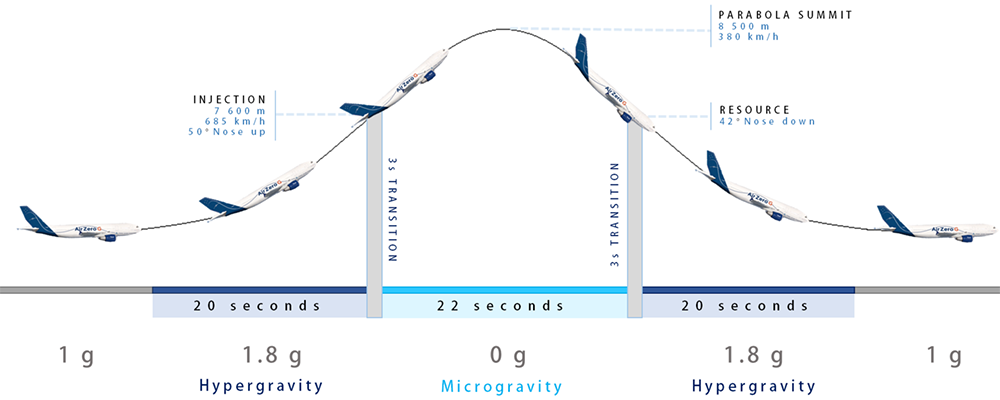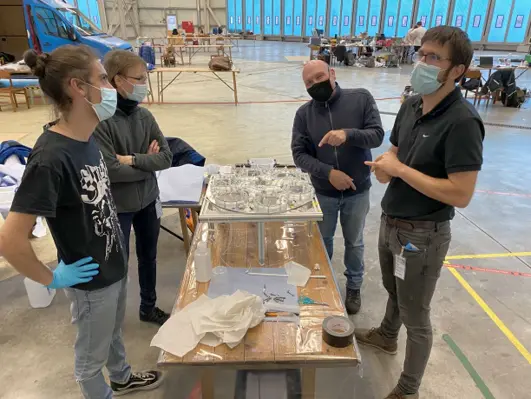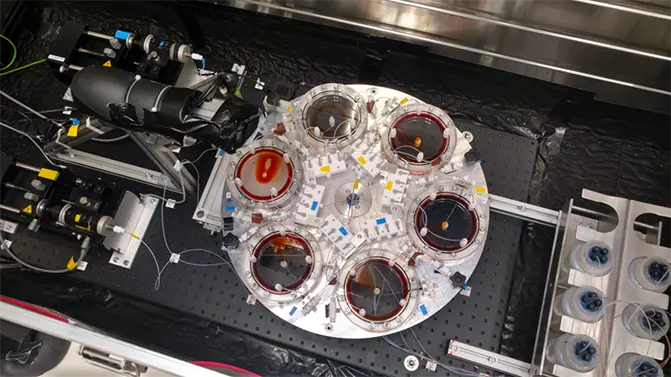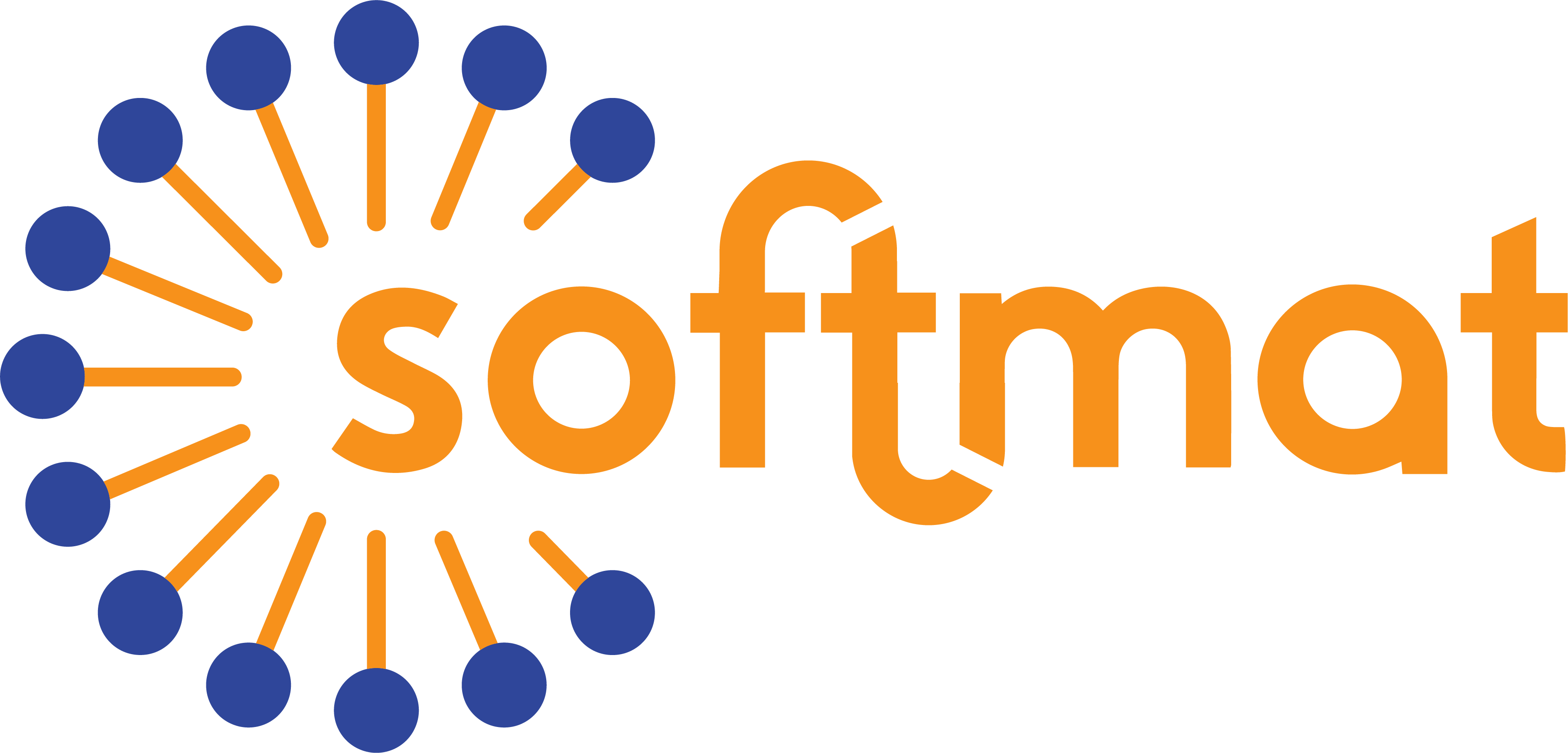Clément Roux and Véronique Pimienta, researchers from the IDeAS team, are members of a ESA-funded Topical Team, called CHYPI which stands for Chemo-HYdronamic Patterns and Instabilities, in collaboration with several European partners: K. Schwartzenberger and Y. Storgiou from Helmoltz Research Center (Dresden, Germany), M. Hauser (Magdeburg University, Germany), D. Horvath, A. Toth and G. Schuszter (University of Szeged, Hungary), A. de Wit, F. Brau and L. Rongy (Université Libre de Bruxelles), M. Budroni (University of Sassari, Italy).
This project aims to study the patterns and instabilities resulting from the coupling between chemical reactions and hydrodynamic flows:
- How can chemical reactions influence or even trigger hydrodynamic instabilities?
- How do flow conditions influence the product and yield of reactions?
Previously, some tests with calcium carbonate
Previously, they tried to better understand the production of a solid where two liquids meet. In particular, with the example of calcium carbonate (CaCO3), they studied how out-of-equilibrium flow conditions can be used to optimize the amount, nature and spatial distribution of solid phases produced by precipitation reactions.
Evaluation of CaCO3 after pattern immobilization was very tricky!
Using CaCO3 was not amenable to even slightly unstable experimental conditions. It was therefore decided to switch to an all-soluble chemical system: Fe3+ and thiocyanate.
A project supported by ESA
In order to avoid buoyancy-driven flows to isolate surface-tension, viscosity or permeability related effects, it was particularly relevant to conduct this study under microgravity conditions.
The topical team submitted the project to ESA which agreed to funding a sounding rocket flight, and beforehand, a parabolic flight in preparation. CNES has also supported Veronique and Clément for a number of years, and contributed financial support towards this particular project.
Indeed, sounding rockets can provide up to 6 minutes at 10-6g, but they are un-manned and considered “one-shot”. Nothing can be left to chance! Preparation and thorough testing in a parabolic flight is often a prerequisite to a sounding rocket experiment.

The parabolic flight campaign
 After a few adventures due to the pandemic crisis, some of the project team members attended in October 2020 a parabolic flight campaign led by Novespace, a CNES spin-off in their Airbus A310 Zero-G aircraft.
After a few adventures due to the pandemic crisis, some of the project team members attended in October 2020 a parabolic flight campaign led by Novespace, a CNES spin-off in their Airbus A310 Zero-G aircraft.
The conditions under which these flights are operated are very challenging. The scientists and the equipment have to endure alternating periods of hypergravity (at 1.8g) and microgravity at 10-2g, during 31 parabolas on board. Concerning the CHYPI project, one particular focus of Novespace, which handles the safety on board the aircraft, was the absolute absence of leaks.

After many months of planning and manufacturing (with contribution from the very talented workshop guys in Helmoltz research center, Dresden), the team spent 5 days to prepare and check the experimental set-up in Paderborn, Germany, just before the flights.
On board, the team recorded a lot of datas (~750 Gb) and filmed the behaviour of the mixture, according to the geometry of the confined reactor. Videos were recorded and were later matched with accurate accelerometer data provided by Novespace.


Overall, the campaign was a great sucess for all involved. Despite the best efforts of both Novespace and the pilots, as well as the scientists on board, the parabolic flights showed some limitations, such as unwanted forward acceleration during pull-up phases, which disturbed some of the observations. Fortunately, these limitations should be totally absent during the sounding rocket experiment.
On the way to the sounding rocket flight
Analysis of the data, led by the Brussels team, is underway to detect the effect to microgravity.
In the medium term, the project team has to collaborate with Airbus which is engineering the fully autonomous system: pumps, valves, Hele-Shaw cells, optics.
All has to be prepared for the launch planned in autumn 2021!
Find out more on ESA website
